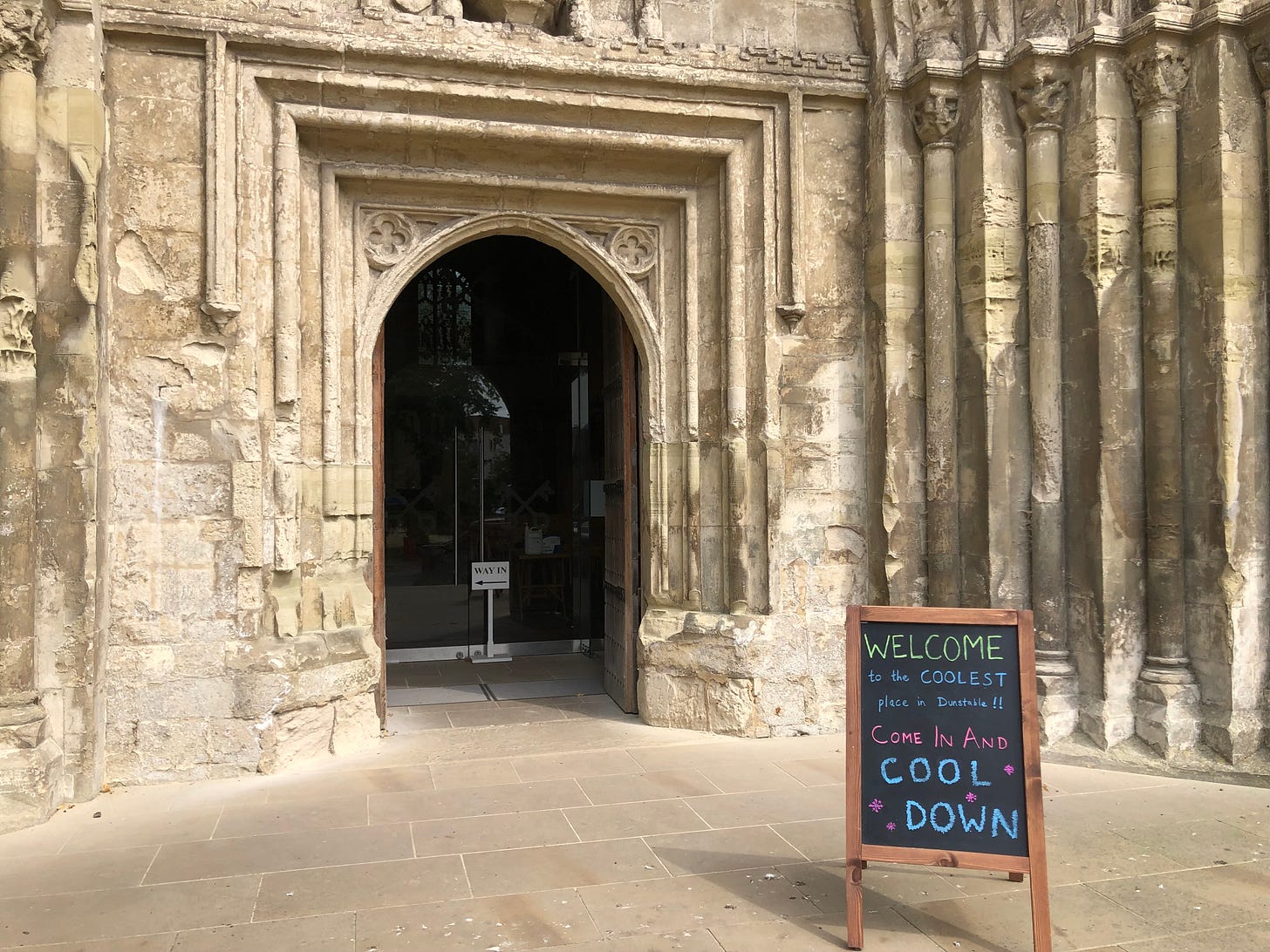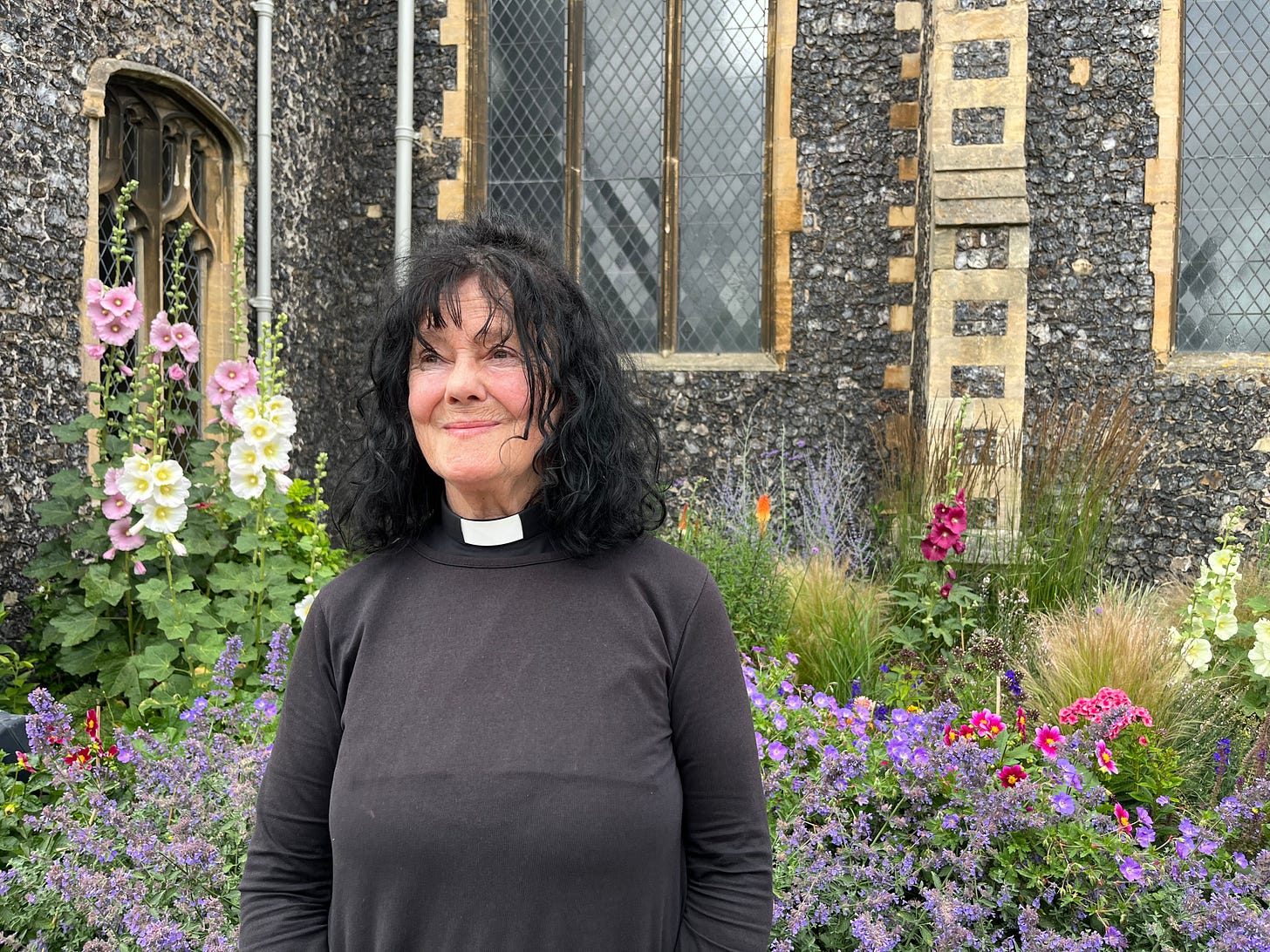Churches say ‘we’re cool’ as climate change supercharges heatwaves
Old stone and concrete buildings are a secret weapon in a warming world

When a heatwave struck the East of England last week, Reverend Annie Blyth stepped through the doors of one of her churches in Norwich – and bathed in mercifully cool air. Parts of St George Colegate date from the 1400s. It’s a big church, with thick stone walls and a high ceiling. The windows are small and high. Tree-dappled natural light from the churchyard filters through.
“The building, I feel, it talks to you,” she asserts. “It just says, ‘Hang on, just stop for a minute.” And people do – especially in the heat. Blyth organises “cool spot” gatherings during episodes of hot weather. Anyone is welcome, she says.
There are tea parties. Some people take their shoes off, to feel the church’s cold stone floor under their feet. Dogs – also very welcome, stresses Blyth – lie there on their tummies. It’s a sanctuary from the blistering conditions outside.
I saw a post on Bluesky this week that reminded me of an initiative sweeping the UK – churches being used as community cool hubs or cool refuges during heatwaves. This emerged in a big way during the unprecedented heat of 2022, which broke multiple temperature records. Heatwaves are likely to become even more common, and there is a risk of 45C days in the UK during the next decade or so, according to the Met Office. Priests like Blyth want to do something in response.
From churches to concrete structures, caves, cellars and bunkers – there are likely a number of potential cool refuges near where you live, which could offer respite to people during hot weather in the future. These places are right under our noses. In general, it might be a good idea to use the infrastructure we already have instead of always building new solutions for climate resilience.
Stone cold St Augustine
Traditional British and Irish churches, large buildings often built using an enormous amount of stone, are notoriously difficult to heat up. That can be a problem on cold winter Sundays but, in the summer, it’s a blessing.
The New York Times recently reported on the rising popularity of air conditioning in the UK as temperatures rise. This is a key consideration for Blyth. “I’m not at all judging of people who use air conditioners but this [church] isn’t using any fuel to cool down, it’s happening quite naturally,” she emphasises.
Less AC, more JC, if you like. St Augustine, who brought Christianity to England in the late 6th Century, and the many church-builders that came after him, could hardly have guessed that religious buildings would one day find a role in terms of climate adaptation. Having said that, churches have always supported a variety of community functions, for example as libraries, theatres and even courtrooms.
“We have these buildings, we can’t knock ‘em down – what we could do is make them work with us,” says Blyth, who in recent years has promoted churches as potential cool refuges. “I just think it’s an under-used resource.”
In a 2023 report on climate resilient churches, the Church of England emphasised the potential value of church buildings as cool spaces. Cathedrals might make particularly good choices. They’re big, and can accommodate a lot of people at once. Some are especially chilly. St Mary’s Episcopal Cathedral in Edinburgh is, according to chatter on social media, known as “the pointy fridge” by choirs.
In contrast, it’s hard to keep many homes in the UK as cool as one would like. Red brick properties can get get very hot in the summer. (Insulation actually reduces solar gain in summer, keeping homes cooler, but can sometimes be associated with increased discomfort in poorly designed buildings, especially at night if occupants don’t open their windows to let cool air in, for example.)
The below graph of temperatures at The Reengineer Headquarters (ahem, my house) during last week’s heatwave gives a sense of how rapidly temperatures can rise in just a few days – and this was in Belfast, which escaped the worst of the hot weather.
Besides churches, there are lots of buildings in communities that could theoretically provide cool refuge. Other religious buildings, for instance. Mosques in Kashmir, a region claimed by both India and Pakistan, are famous for offering people a chance to escape the heat.
When a heatwave hit Berlin in 2018, some people flooded into old, concrete World War II bunkers to cool down. Caves have occasionally provided a form of cool refuge during extreme heat events – including “The Devil’s Arse” in the Peak District. Quite the alternative to your local chapel.
Get the chills
Separately, tourists in Paris are sometimes advised to visit the city’s famous skeleton-packed underground catacombs during hot weather. However, it’s wise to take care in such places. In 2017, two teenage boys were treated for hypothermia after spending three days lost in the labyrinthine catacombs.
You get the idea, though. Cool hubs of various flavours already exist – many people could, in principle, access one no matter where they live.

Historic England, a public body that looks after various heritage sites in England, has considered this. In written evidence submitted to a parliamentary committee in 2023, the organisation highlighted the potential usefulness of cool refuges in certain buildings during climate change-exacerbated heatwaves: “It is essential these buildings are protected, well maintained, and recognised in national and local heat resilience plans and policies.”
Such buildings could include libraries and museums as well as churches, suggests Historic England. A spokeswoman adds that the body has commissioned research into passive cooling measures including awnings and shutters, which have long been used to reduce solar gain in buildings. The intention is to be able to provide advice to owners and managers of historic properties as to how they can make the most of such measures. This research will be published later this year.
Meanwhile, the National Trust, a charity, tells The Reengineer that there are various well-known cool hubs at some of its properties. The medieval Cellarium at Mottisfont Abbey, a country estate in Hampshire, is “gorgeously cool”, apparently, and Stowe Gardens in Buckinghamshire boast multiple temples that are opened daily for shelter from the rain and hot weather. “Some properties like Ickworth Estate have advice for visitors on where they can cool down when it’s too hot, like The Servants’ Quarters in the basement,” a spokeswoman adds.
In the coming years, all of this could be increasingly relevant. Climate change is “the greatest concern of our age”, says Blyth. And in the face of the threats it poses to communities around the UK, she argues that churches offer a way to help people: “Every village has got a church, hasn’t it?”
When I ask whether there is any biblical precedent for using churches as cool refuges, Blyth refers to the famous commandment: love thy neighbour. Help people how you can, where you can. “The Bible wants us to be practical,” she says. “And love each other in small, practical ways.”
Further reading on this week’s story
The Church of England has published a case study that details how one of its churches in Manchester offered a cool refuge to people during the 2022 heatwave. “Over the three days of the heatwave, St Mary’s was able to stay relatively cool, remaining under 20C until the final afternoon,” the document reveals.
This story from The Bureau of Investigative Journalism offers a deep dive on why British homes can get unbearably hot internally during heatwaves.
In 2021, Historic England hosted a webinar on the problem of overheating in some heritage properties.
Update: Clarified the role of insulation and solar gain.
Thanks for reading! If you enjoyed this story, don’t forget to share it with your friends and colleagues. You can also subscribe to The Reengineer and follow me on Bluesky.




